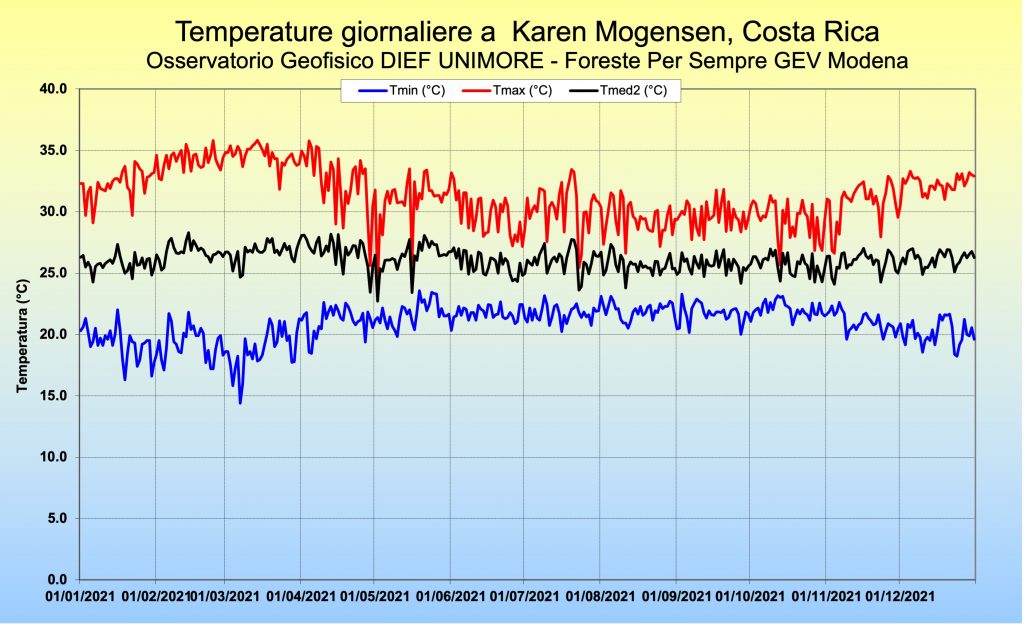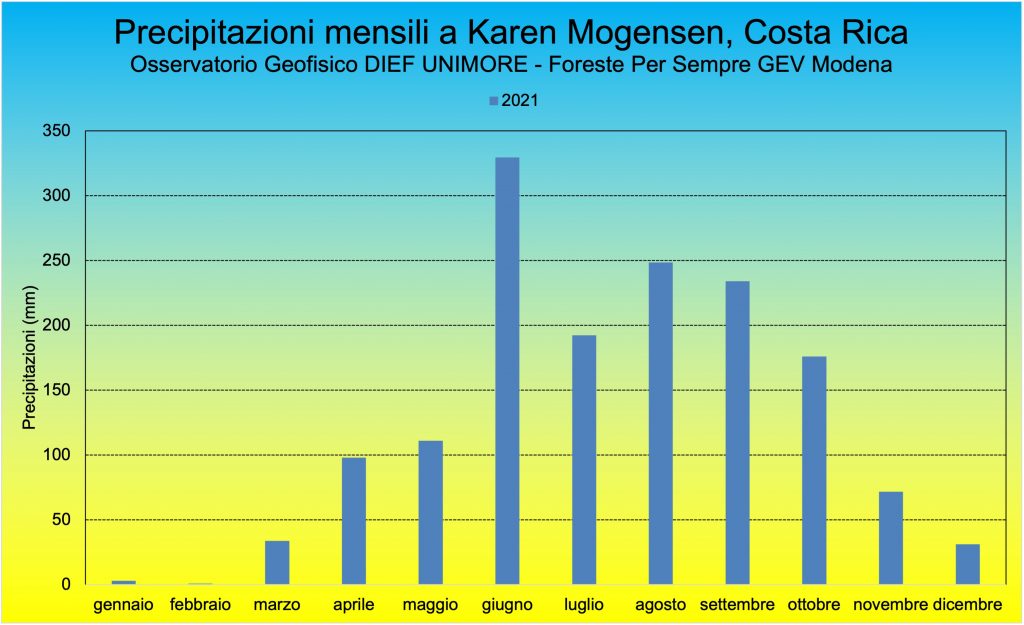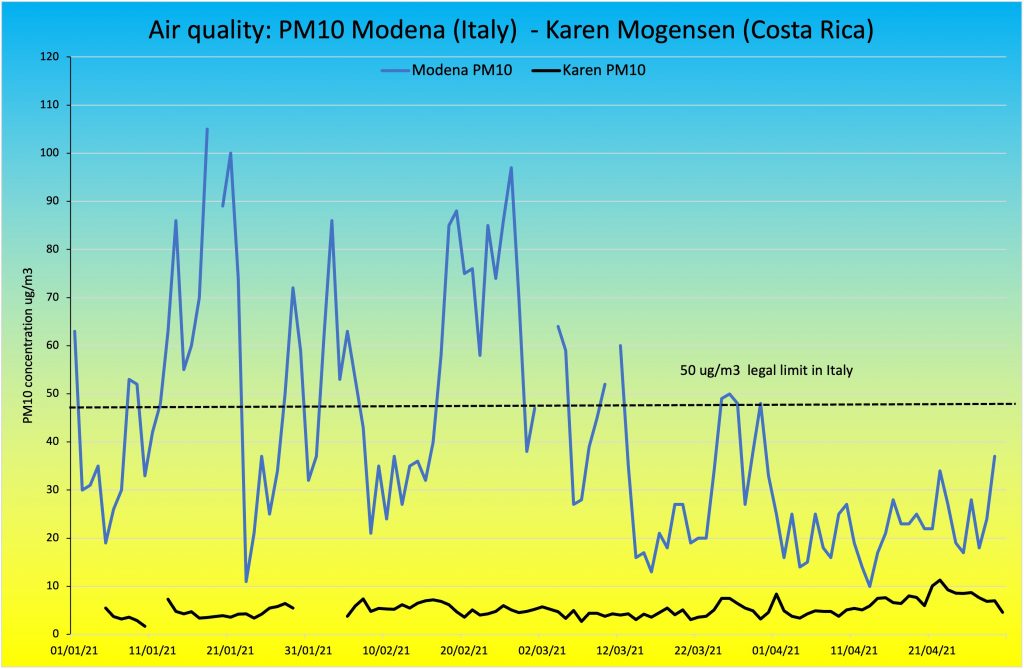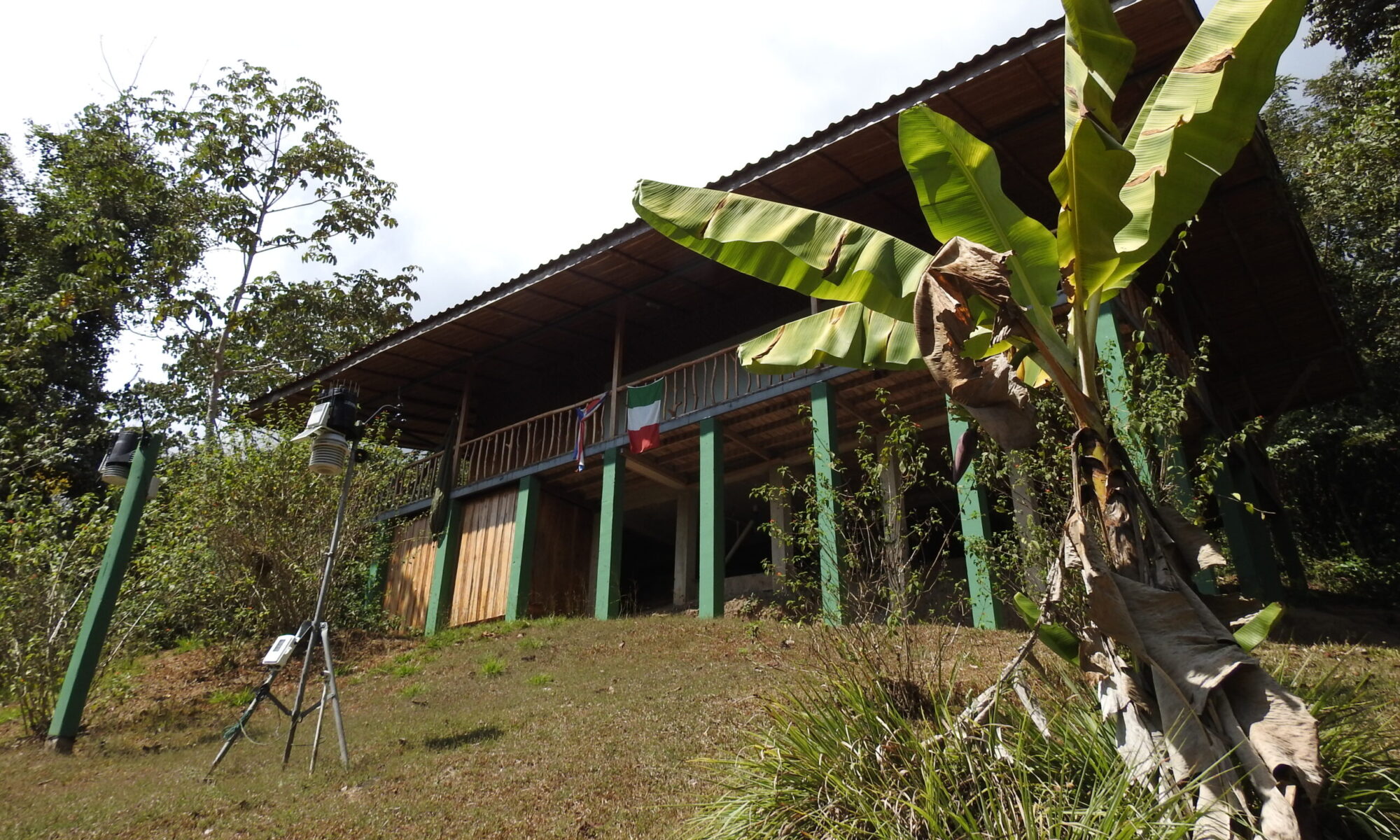Summary of meteorological observations of the year 2021 at the “Italia Costa Rica” Meteoclimatic and Biological Station, Karen Mogensen Reserve, Costa Rica
By Luca Lombroso, AMPRO Meteorologist
DIEF UNIMORE – Geophysical Observatory and Foreste per Sempre OdV
Introduction
This is the fourth year of continuous weather measurements at the Karen Mogensen Reserve. The experience began with the CLIMBIO 2016 experimental scientific expedition, in which the webcam was installed, still functioning and controlled at the time, the weather station already existing, which later turned out to be obsolete and with various problems. From February 2017 then, brought by prof. Dario Sonetti, a Davis Vantage Pro Plus professional station is in continuous operation, complete with classic weather sensors and solar and ultraviolet radiation measuring instruments.
The first data that emerges from the analysis of the weather data of the year 2021 is, with satisfaction, the complete and continuous availability of data without interruptions, which has made it possible to draw up the daily summaries. It was not obvious, in a period still of COVID-19 limitations in Italy and Costa Rica. This was possible thanks to the remote control at the weather room of the Geophysical Observatory of the “Enzo Ferrari” Engineering Department, University of Modena and Reggio. Emilia as well as the basic maintenance performed by prof. Dario Sonetti during his visits and stays at the Karen Mogensen Reserve Station.
From December 2021 some deterioration in the accuracy of the maximum temperature measurements have been noted, which will be resolved during the visit to the Reserve by the meteorologist Luca Lombroso at the end of January 2022. The data for this period have been appropriately corrected to make them usable for this preliminary analysis.
Temperature analysis
The average temperature of the year 2021 in Karen Mogensen was 26.1 ° C. The value is substantially similar to that of the year 2020 (26.3 °) and 2019 (26.1 ° C), while due to the presence of the La Niña phenomenon in 2019 it was lower, 25.4 ° C.
On the hottest day the maximum temperature reached 35.8 ° C. this took place, with the same value, over several days. On February 24, March 14 and then April 4, 2022. In 2021, however, higher values were reached, up to 37.4 ° C.
The coolest night was March 7, with a minimum temperature of 14.3 ° C.
In the year there are 265 “hot days” with maximum temperatures equal to or above 30 ° C, and 276 “tropical nights” with minimum temperatures greater than or equal to 20 ° C.

Rainfall
In 2021 the rains totalled 1529.4 mm, it was a dry year, with the lowest rainfall since the start of the measurements, with a shortage of 22% of rainfall compared to the 2017-2021 average (1949.0 mm).
The first significant rains at the end of the dry season came on April 16, but for the rest of the month and all of May the rains were occasional. Only from 3 June 2021 did the rainy season begin in full, with almost daily rainfall. In July there are some dry days, the classic “veranillo” between 15 and 21. Almost daily rains in August and first half of September, while the last 10 days of September have strangely seen very scarce rainfall with several days without rain. Even in October the rains were scarce, with 176.0 mm, compared to the climatology with several days without precipitation in what climatically, with a value of 413.8 mm, should be the wettest month.
In November it still rains in the first decade, then the frequency of rainfall has decreased with the end of the rainy season, which can be placed on 11 November. Subsequently, sporadic light rains are observed, with the last significant precipitation on 17 December with 17.4 mm.
The wettest day was September 5th with 89.2 mm. During the year there are 121 rainy days with at least 1 mm collected by the rain gauge, and 180 days with measurable rainfall.

Other data
The wind data at the moment, for the not very appropriate location of the anemometer, are not representative. An interesting fact is the high intensity of cumulative solar radiation, 4960.0 MJ / m2, and especially of UV radiation, equal to 4615.9 MEDs, the highest value recorded so far from 2017 to today.
Climatic considerations
The dataset available so far is too short to make any correlation considerations with global climate change. It is however interesting to note that the average temperatures were high despite a moderate La Nina phenomenon in the last months of the year.
It is also important to highlight the low rainfall of the year, with rains much lower than the average and irregular rainfall patterns even in the culminating phase of the rainy season, September and October.
Air quality and CO2 measurements
At the end of 2020 it was brought by prof. Dario Sonetti, a sensor for air quality and CO2 concentrations. The sensor needs further checks and adjustments, as it is an experimental prototype.
However, the collected data show excellent air quality, often the PM2.5 values are at the limits of detectability and the PM almost always lower than 10 ug / m3.
The CO2 measurements are in line with global concentrations, and show a day cycle attributable in part to the absorption / release cycle of the vegetation and partly to meteorological reasons, due to the day and night trend of the height of the mixed layer. The absolute values are now not mentioned because further details of their calibration are necessary.

Conclusions
The data so far tales are very interesting, and constitute a fundamental set of observations to compare them with the behaviour of biodiversity, both for naturalistic purposes and for scientific research.
In fact, the series of measurements is still short, but from year to year it is enriched and already now, combined with reanalysis techniques, it can form the basis for research and applications in meteorology and climatology.
Furthermore, in 2021 the data was entered into a database of the Geophysical Observatory of Modena, so as to facilitate its usability, also with a special page with an archive in text format and graphics at the address https://meteo.unimore.it / weather / ossgeo / weewx / karen /
It is therefore desirable to consolidate current activities, also looking for new projects and sources of funding to improve the instrumentation or expand the measures.
What Prof. Domenico Ragona, director of the Geophysical Observatory of Modena said from 1862 to 1892, also applies very well to the weather station at the Karen Mogensen reserve: “We must be delighted with our contribution to the benefit of meteorology, because we will transmit our posterity what our ancestors transmitted to us, that is a myriad of observations and an immense copy of meteorological documents “

